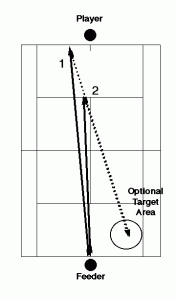| Step #1 — Players line up on baseline in one or two single file lines, depending on the number of players, coaches and courts you have available. Step #2 — Feeder feeds a deep ball and player hits to a designated area on the court.
Step #3 — Feeder fees a short ball (on or behind the service line) which is easily playable by the baseline player, but requires the player to come at least four or more steps off the baseline. Player must hit he ball to a realistic target area (deep and down the middle to the neutral zone, or deep to one corner). Targets areas will vary depending on whether your are drilling doubles or singles players. Depending on the number of players you have, players should repeat this sequence three times before returning to the end of the line to respect the learning of strokes skills (i.e., to make this drill at all useful). With larger numbers, feeder can skip the first deep feed. All feeds should be relatively consistent to allow the player three attempts with the same stroke (e.g., a high-sitting short forehand or a low backhand). Coach gives no instruction up to this point, allowing players to experiment, with success or failure in hitting the target areas providing the feedback.
Option #1 — Coach can set markers on the court to which the player must move after the shot, requiring them to continue moving forward to the net after they hit the shot and before returning to the baseline, in order to prevent players from bailing out the stroke too early and retreating prior to or during the stroke.
Step #4 — After each player has had a chance to work on playing short balls twice, coach stops drill and brings players in to discuss how to play short balls. Discuss the different path taken to a short ball than to a deep ball. Make sure players understand the importance of getting around to the side of the ball, and the 45 degree approach path this will take. Let players know they must position themselves in order to get their entire body into the ball, rather than just hitting the ball with their arm. Let players know it’s OK to continue on to the net.
Step #5 — Players return to the drill and attempt it with the new knowledge of footwork, body balance and positioning.
Step #6 — After players have worked on the skill for several to 10 minutes, the drill becomes more matchlike. Players must return to the end of the line any time their approach shot does not land in the playing area (the singles court for singles players, crosscourt for doubles players).
Step #7 — After players have worked on Step #6 several to 10 minutes, the drill becomes even more matchlike. Players must return to the end of the line any time their approach shot does not land in and deep (three-quarters court or deeper, depending on the skill level of players). With weaker players, the drill can progress from approach shots needing to land past the service to approach shots eventually needing to land three-quarters court or deeper.
Option #2 — After the drill has been run, the progression of feeds can include several random deep balls (forehands and backhands), with a final short ball which must be played to a realistic target area.
Option #3 — After players have begun to master the skill of playing through the mid court, the skill can be practiced as part of shots combinations that include a volley fed after the short ball and finishing with an overhead.
Option #4 — Coach can break drill and discuss the mechanics of hitting from the mid-court, in addition to the footwork, boy balance and positioning (see referenced articles and drills for more on this). |







